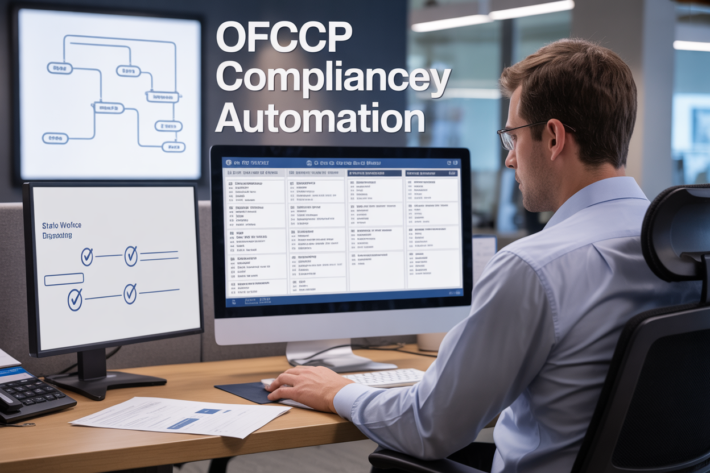Unlocking OFCCP Compliance: How Automation Keeps You Audit-Ready

Federal contractors face mounting pressure to maintain OFCCP compliance while managing complex affirmative action requirements. Manual processes often leave gaps that put your organization at risk during federal contractor audits.
This guide is designed for HR leaders, compliance officers, and federal contractors who need streamlined solutions to stay audit-ready without overwhelming their teams.
We’ll explore how OFCCP automation software addresses the most common compliance challenges that create audit risk. You’ll discover the essential features that transform manual processes into automated compliance solutions. Finally, we’ll show you how to build a solid foundation that keeps your organization prepared for any OFCCP audit.
The days of scrambling through spreadsheets and hoping your documentation passes inspection are over. Let’s explore how automation makes federal contractor compliance more manageable and reliable.
Understanding OFCCP Compliance Requirements
Key regulations that impact federal contractors
Federal contractors face a complex web of OFCCP compliance requirements centered around three core regulations. Executive Order 11246 forms the backbone of affirmative action obligations, requiring contractors with 50 or more employees and contracts exceeding $50,000 to develop written affirmative action plans. Section 503 of the Rehabilitation Act mandates equal employment opportunities for individuals with disabilities, while the Vietnam Era Veterans’ Readjustment Assistance Act (VEVRAA) extends similar protections to covered veterans.
These regulations create overlapping compliance obligations that impact every aspect of the employment lifecycle. Contractors must maintain specific utilization analyses, establish placement goals, and demonstrate reasonable faith efforts to achieve diversity objectives. The regulations also require detailed record-keeping of recruitment activities, applicant flow data, and compensation analyses to identify potential disparities.
Common audit triggers and red flags
OFCCP audit selection isn’t random—specific patterns and indicators dramatically increase your chances of being selected for review. Significant changes in workforce demographics often trigger scrutiny, particularly when minority or female representation drops substantially. Compensation disparities identified through statistical analysis frequently catch an auditor’s attention, especially when pay gaps correlate with protected class status.
Employee complaints filed with OFCCP create immediate audit risks. Even unfounded complaints can lead to comprehensive desk audits that expand beyond the original issue. Geographic location also plays a role—contractors in areas with historically low compliance rates face higher selection probabilities.
Missing or late AAP updates signal compliance weaknesses that auditors actively monitor. Contractors who fail to submit required reports or miss regulatory deadlines often find themselves prioritized for review. Previous violations or consent agreements create lasting audit vulnerability, as OFCCP maintains detailed compliance histories.
Documentation standards that auditors expect
Auditors expect comprehensive and organized documentation that demonstrates systematic compliance efforts, rather than reactive responses. Your affirmative action plans must include detailed utilization analyses with current availability data, specific placement goals with supporting rationales, and documented reasonable faith efforts with measurable outcomes.
Personnel records require meticulous organization, with complete applicant flow data that includes self-identification information and detailed recruitment activities. Compensation records must demonstrate systematic pay equity analyses, including statistical testing results and remediation documentation, when disparities exist.
Training records, policy distributions, and communication logs demonstrate the organization’s commitment to compliance. Auditors look for evidence of regular compliance monitoring, corrective actions taken when problems arise, and continuous improvement efforts. Documentation gaps or inconsistencies raise immediate red flags that can transform routine reviews into expanded investigations.
Timeline pressures during compliance reviews
OFCCP compliance reviews operate under tight deadlines that can overwhelm unprepared contractors. The initial scheduling letter typically provides only 30 days to prepare extensive documentation packages. This compressed timeframe requires immediate mobilization of resources across HR, legal, and operational teams.
Desk audits demand rapid data compilation and analysis. You’ll need to produce years of personnel records, compensation data, and compliance documentation while maintaining normal business operations. Missing deadlines or submitting incomplete responses can lead to escalated reviews and increased potential penalties.
On-site reviews intensify time pressures with concurrent document requests, employee interviews, and facility inspections. Auditors expect immediate responses to information requests and real-time access to systems and records. Delays or organizational confusion during on-site visits create negative impressions that influence audit outcomes and potential enforcement actions.
Manual Compliance Challenges That Create Risk
Human Error in Data Collection and Reporting
Federal contractor compliance relies heavily on accurate data collection and meticulous record-keeping; however, manual processes introduce numerous opportunities for errors. When HR teams manually track employee demographics, compensation data, and hiring statistics, simple typos can snowball into significant OFCCP audit preparation problems. A misplaced decimal point in salary information or incorrect EEO-1 category assignments can trigger red flags during an OFCCP audit.
The complexity of affirmative action compliance requirements makes human error almost inevitable. Staff members must navigate multiple data sources, cross-reference employee information, and ensure consistency across various reporting formats to maintain accurate and reliable data. Without automated compliance solutions, even the most diligent employees can accidentally duplicate entries, miss required fields, or misinterpret reporting criteria.
These errors become particularly problematic when the Office of Federal Contract Compliance Programs requests specific documentation. Inaccurate baseline data means your entire compliance narrative becomes questionable, potentially extending audit timelines and increasing scrutiny of your federal contractor compliance program.
Time-Intensive Processes That Delay Responses
Manual OFCCP compliance management creates bottlenecks that can jeopardize your audit timeline. When compliance officers must manually compile reports from multiple systems, the process often takes weeks rather than days. This delay becomes critical during an actual audit when you have limited time to respond to information requests.
Consider the typical scenario: An OFCCP investigator requests three years of hiring data broken down by job group, race, and gender. Without compliance management automation, your team must manually extract data from your HRIS, cross-reference it with applicant tracking systems, and format everything according to OFCCP specifications. This process typically requires 40 to 60 hours of staff time.
The time crunch intensifies when multiple departments need to coordinate their efforts. Payroll must provide compensation analysis, HR needs to compile adverse impact studies, and facilities management might need to document accessibility compliance. Manual coordination of these efforts often results in missed deadlines and incomplete submissions.
Inconsistent Documentation Across Departments
Different departments often maintain their own documentation standards, resulting in a patchwork of compliance records that lack cohesion. Your recruiting team may use one format for applicant tracking, while HR maintains employee records in a separate system. This fragmentation makes it nearly impossible to present a unified compliance picture during an audit.
Inconsistencies also emerge in how departments interpret OFCCP compliance requirements. Without standardized processes, one manager might document accommodation requests differently from another, or various locations might apply different standards for job group classifications. These discrepancies signal poor internal controls to OFCCP investigators.
The documentation problem extends beyond format inconsistencies to include gaps in record retention. While one department diligently maintains required records, another might inadvertently delete important files or fail to archive compliance documentation properly. This scattered approach to federal contractor audit preparation creates vulnerabilities that auditors quickly identify and investigate.
How Automation Transforms OFCCP Compliance Management
Streamlined Data Collection from Multiple HR Systems
Modern organizations juggle data across countless HR systems – from applicant tracking systems to payroll platforms, performance management tools, and benefits administration. OFCCP compliance automation eliminates the headache of manually extracting and consolidating this scattered information. Advanced automation solutions create seamless connections between these disparate systems, pulling relevant data automatically and organizing it into compliance-ready formats.
This integration capability transforms how federal contractors handle their compliance obligations. Instead of spending weeks gathering employee demographics, compensation data, and hiring statistics from various platforms, automation tools can compile comprehensive datasets in just a few hours. The software intelligently maps data fields across systems, ensuring consistency and accuracy while reducing the human error that often plagues manual data collection efforts.
Real-Time Monitoring of Compliance Metrics
Automated compliance solutions provide continuous oversight of critical OFCCP metrics, delivering instant visibility into your organization’s compliance status. These systems track key indicators, such as diversity ratios, pay equity measurements, and affirmative action goals, alerting compliance teams when metrics deviate outside acceptable ranges.
Real-time dashboards display compliance health at a glance, highlighting areas that need attention before they become audit liabilities. This proactive approach enables organizations to address potential issues promptly, rather than discovering problems during the OFCCP audit preparation phase. Automated alerts can notify relevant stakeholders when specific thresholds are reached, enabling swift corrective action that keeps your organization ahead of compliance requirements.
Automated Report Generation for Audit Requests
When federal contractor audit requests arrive, time becomes your most valuable asset. OFCCP automation software transforms the traditionally stressful report generation process into a streamlined operation. These systems maintain pre-configured report templates that align with standard OFCCP requirements, automatically populating them with current data whenever needed.
The software can generate multiple report formats simultaneously, from basic demographic breakdowns to complex statistical analyses required for affirmative action compliance. This capability ensures audit responses are comprehensive, accurate, and delivered within required timeframes. Organizations that previously struggled to meet tight audit deadlines now find themselves OFCCP audit-ready with professional-quality reports produced in minutes rather than weeks.
Centralized Documentation Storage and Retrieval
Compliance management automation creates a single source of truth for all OFCCP-related documentation. This centralized approach replaces scattered filing systems with organized, searchable repositories that make information retrieval effortless. The system automatically categorizes documents, applies appropriate retention schedules, and maintains audit trails for all compliance activities.
Smart search functionality allows users to locate specific documents instantly using keywords, date ranges, or document types. Version control features ensure teams continuously work with the most current information while preserving historical records for compliance purposes. This centralized approach significantly reduces the time and stress associated with audit preparation, as all required documentation remains readily accessible and properly organized.
Essential Features of OFCCP Automation Solutions
Integration Capabilities with Existing HRIS Platforms
The backbone of effective OFCCP compliance automation lies in seamless data connectivity. Modern OFCCP automation software must integrate effortlessly with your existing Human Resource Information Systems (HRIS), payroll platforms, and applicant tracking systems. This integration eliminates the time-consuming process of manual data entry and reduces the risk of human error that could jeopardize your federal contractor compliance.
Quality integration capabilities enable real-time data synchronization across platforms, ensuring that your compliance tracking accurately reflects the most current workforce demographics, hiring patterns, and compensation structures. When your OFCCP automation solution connects directly with platforms like Workday, ADP, or SAP SuccessFactors, it automatically pulls employee data, job postings, and hiring metrics without requiring additional administrative overhead.
The most robust automated compliance solutions support API connections, data mapping customization, and scheduled data refreshes. This means your compliance team can focus on strategic analysis rather than collecting and validating data. Integration also enables cross-platform reporting, allowing HR teams to view compliance metrics alongside operational data, thereby creating a holistic view of workforce management that supports both business objectives and regulatory requirements.
Customizable Reporting Dashboards and Analytics
OFCCP audit preparation demands sophisticated reporting capabilities that go beyond basic demographic breakdowns. Advanced compliance management automation platforms provide fully customizable dashboards, enabling compliance officers to create targeted reports tailored to different stakeholders and audit scenarios.
These dashboards should provide real-time visibility into key compliance metrics, including workforce utilization analysis, recruitment source effectiveness, and compensation equity trends. The best OFCCP automation software enables users to build custom reports that align with specific organizational structures, job groups, and geographic locations. This flexibility proves invaluable during federal contractor audits when OFCCP investigators request specific data cuts or historical trend analysis.
Interactive analytics capabilities transform raw compliance data into actionable insights. Look for solutions that offer drag-and-drop report builders, automated alert systems for potential compliance issues, and executive-level summary views. These features enable proactive compliance management, allowing organizations to identify and address potential disparities before they become audit findings.
Automated Adverse Impact Analysis Tools
Adverse impact analysis represents one of the most complex aspects of affirmative action compliance, requiring statistical expertise and careful attention to OFCCP guidelines. Automated adverse impact analysis tools eliminate guesswork by applying standardized statistical tests and thresholds consistently across all personnel actions.
These tools automatically calculate the four-fifths rule compliance, perform chi-square and Fisher’s exact tests, and generate the statistical documentation required for OFCCP audit-ready submissions. Advanced solutions can analyze adverse impact across multiple dimensions simultaneously, including race, gender, veteran status, and disability status, while accounting for job group classifications and geographic considerations.
The most sophisticated automated compliance solutions provide contextual guidance alongside statistical results, helping compliance teams understand when statistical significance requires further investigation and when observed differences fall within acceptable ranges. These tools also maintain historical analysis records, creating an audit trail that demonstrates ongoing monitoring and reasonable efforts to address potential disparities.
Modern adverse impact analysis automation includes predictive capabilities that model the potential impact of proposed hiring decisions, enabling proactive adjustments to recruitment and selection processes before adverse impact occurs.
Building Your Audit-Ready Foundation
Setting Up Proactive Compliance Monitoring Systems
Successful OFCCP compliance automation starts with establishing real-time monitoring systems that catch potential issues before they become audit problems. Your monitoring system should continuously track key metrics like applicant flow data, hiring patterns, compensation analysis, and workforce demographics. Set up automated alerts that trigger when statistical disparities emerge or when data collection gaps occur.
The best proactive systems integrate directly with your HRIS and applicant tracking systems, creating a seamless data pipeline. Configure dashboards that provide instant visibility into compliance status across all required categories. Innovative monitoring tools can identify trends that might indicate systemic issues, such as declining diversity in certain job groups or compensation discrepancies that could signal potential violations.
Regular automated reports should be generated on a monthly and quarterly basis, providing a detailed analysis of your organization’s compliance posture. These reports become invaluable during OFCCP audit preparation, demonstrating your commitment to ongoing compliance management.
Creating Standardized Workflows for Data Management
Inconsistent data handling creates the most significant compliance vulnerabilities for federal contractors. Establish clear, standardized workflows that govern how applicant data is collected, stored, and analyzed throughout your organization. Every touchpoint in your hiring process should follow documented procedures that ensure OFCCP compliance requirements are met.
Your automated compliance solutions should enforce these workflows automatically. When recruiters post jobs, the system should prompt them to include required affirmative action language. When applications are received, automated workflows should ensure the proper collection and storage of demographic data. Interview scheduling, offer processes, and onboarding should all follow predefined compliance pathways.
Document retention workflows are equally critical. Your system should automatically archive required records for the appropriate retention periods while flagging documents approaching disposal dates. Standardized workflows eliminate the guesswork and human error that often lead to compliance failures during federal contractor audits.
Training Teams on Automated Compliance Processes
Technology alone doesn’t guarantee OFCCP compliance success. Your teams need comprehensive training on how to work effectively with automated compliance systems. HR staff, recruiters, and hiring managers must understand not only how to use the tools but also why each step is crucial for maintaining audit readiness.
Training should cover both technical system operation and compliance principles. Staff need to understand how their daily actions contribute to overall affirmative action compliance and what happens when processes aren’t followed correctly. Role-specific training ensures recruiters know how to properly use applicant tracking features while managers understand their responsibilities for compensation analysis and adverse impact monitoring.
Regular refresher training keeps teams up to date as systems evolve and regulations change. Create user guides and quick reference materials that support ongoing compliance management. When your team truly understands both the technology and the compliance requirements, your automated systems become much more effective.
Establishing Regular System Maintenance Protocols
OFCCP automation software requires ongoing maintenance to remain effective and compliant with audits. Establish monthly system health checks that verify data integrity, test automated workflows, and ensure all integrations are functioning correctly. These protocols should include reviewing user access permissions, updating job group classifications, and validating compensation analysis algorithms.
Quarterly maintenance should include more comprehensive reviews of system performance and the effectiveness of compliance. Analyze trending data to identify areas where your automated processes might need adjustment. Review and update standardized workflows based on lessons learned and regulatory changes.
Annual maintenance protocols should align with your affirmative action plan updates and include comprehensive system audits to ensure ongoing compliance. This is when you evaluate whether your current automation solution still meets your organization’s needs and compliance requirements. Regular maintenance prevents minor issues from escalating into major compliance problems and ensures your systems remain audit-ready throughout the year.
OFCCP compliance doesn’t have to be a constant source of stress for your organization. The manual processes that once left companies scrambling during audits are becoming a thing of the past. Innovative automation tools now handle the heavy lifting of data collection, report generation, and deadline tracking, giving you the confidence that comes from knowing your compliance foundation is rock-solid.
The path forward is clear: embrace automation solutions that offer real-time monitoring, automated reporting, and comprehensive audit trails. These tools don’t just make compliance easier – they transform it from a reactive scramble into a proactive strategy. Begin by assessing your current compliance gaps and selecting an automation platform that scales with your evolving needs. Your future audit-ready self will thank you for investing today.
Scaling candidate pipelines requires automation that connects to the channels job seekers trust most. Explore our Handshake, WayUp, and ZipRecruiter integrations to diversify outreach, and check the Job Boards category for strategies that improve visibility. Whether you’re focused on early-career talent or high-volume hiring, Job Multiposter and Job Distribution make it easier to post everywhere while saving time.


